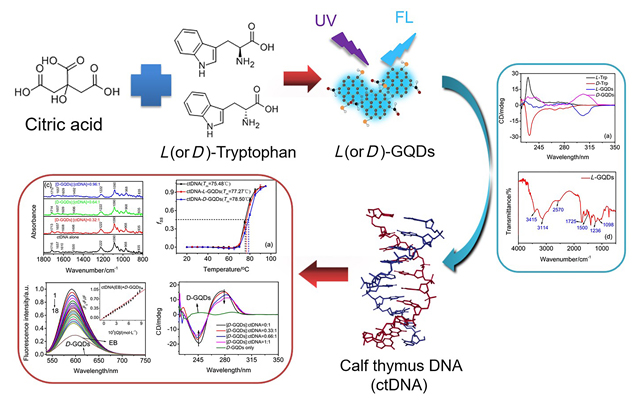[1] Crassous, J. Chem. Soc. Rev. 2009, 38, 830.
[2] Li, Q.; Jia, Y.; Li, J. B. Acta Chim. Sinica 2019, 77, 1173. (李琦, 贾怡, 李峻柏, 化学学报, 2019, 77, 1173.)
[3] Xiong, F.; Li, L. Chinese J. Org. Chem. 2018, 38, 2927. (熊斐, 李莉, 有机化学, 2018, 38, 2927.)
[4] Cai, J.; Hao, C.; Sun, M.; Ma, W.; Xu, C.; Kuang, H. Small 2018, 14, 1703931.
[5] Mohammadi, E.; Tsakmakidis, K. L.; Askarpour, A. N.; Dehkhoda, P.; Tavakkoli, A.; Altug, H. ACS Photonics 2018, 5, 2669.
[6] Liu, G. J.; Shi, H. Chinese J. Org. Chem. 2016, 36, 2583.
[7] Liu, Q.; Guo, B. D.; Rao, Z. Y.; Zhang, B. H.; Gong, J. R. Nano Lett. 2013, 13, 2436.
[8] Ge, S. Y.; He, J. B.; Ma, C. T.; Liu, J. Y.; Xi, F. N.; Dong, X. P. Talanta 2019, 199, 581.
[9] Lu, H. T.; Li, W. J.; Dong, H. F.; Wei, M. L. Small 2019, 15, 1902136.
[10] Sajjadi, S.; Khataee, A.; Soltani, R. D. C.; Hasanzadeh, A. J. Phys. Chem. Solids 2019, 127, 140.
[11] Zhou, X. Q.; Sun, Q.; Jiang, L.; Li, S. T.; Gu, W.; Tian, J. L.; Liu, X.; Yan, S. P. Dalton Trans. 2015, 44, 9516.
[12] Carrillo-Carrión, C.; Cárdenas, S.; Simonet, B. M.; Simonet, B. M.; Valcárcel, M. Anal. Chem. 2009, 81, 4730.
[13] Zeng, C. J.; Jin, R. C. Chem 2017, 12, 1839.
[14] Jiang, S.; Chekini, M.; Qu, Z. B.; Wang, Y. C.; Yeltik, A.; Liu, Y. G.; Kotlyar, A.; Zhang, T. Y.; Li, B.; Demir, H. V.; Kotov, N. A. J. Am. Chem. Soc. 2017, 139, 13701.
[15] Li, F.; Li, Y. Y.; Yang, X.; Han, X. X.; Yang, J.; Wei, T. T.; Yang, D. Y.; Xu, H. P.; Nie, G. J. Angew. Chem., Int. Ed. 2018, 57, 2377.
[16] Suzuki, N.; Wang, Y. C.; Elvati, P.; Qu, Z. B.; Kim, K.; Jiang, S.; Baumeister, E.; Lee, J.; Yeom, B. J.; Bahng, J. H.; Lee, J.; Violi, A.; Kotov, N. A. ACS Nano 2016, 10, 1744.
[17] Xu, L. G.; Xu, Z.; Ma, W.; Liu, L. Q.; Wang, L. B.; Kuang, H.; Xu, C. H. J. Mater. Chem. B 2013, 1, 4478.
[18] Gan, Z.; Xu, H.; Hao, Y. Nanoscale 2016, 8, 7794.
[19] Xu, M. H.; He, G. L.; Li, Z. H.; He, F. J.; Gao, F.; Su, Y. J.; Zhang, L. Y.; Yang, Z.; Zhang, Y. F. Nanoscale 2014, 6, 10307.
[20] Singh, H.; Sreedharan, S.; Tiwari, K.; Green, N. H.; Smythe, C.; Pramanik, S. K.; Thomas, J. A.; Das, A. Chem. Commun. 2019, 55, 52.
[21] SimoEs, E. F. C.; Da Silva, J. C. G. E.; LeitaO, J. M. M. Anal. Chim. Acta 2014, 852, 174.
[22] Liu, Z. G.; Xiao, J. C.; Wu, X. W.; Lin, L. Q.; Weng, S. H.; Chen, M.; Cai, X. H.; Lin, X. H. Sens. Actuators, B 2016, 229, 217.
[23] Peng, J.; Gao, W.; Gupta, B. K.; Liu, Z.; Romero-Aburto, R.; Ge, L. H.; Song, L.; Alemany, L. B.; Zhan, X. B.; Gao, G. H.; Vithayathil, S. A.; Kaipparettu, B. A.; Marti, A. A.; Hayashi, T.; Zhu, J. J.; Ajayan, P. M. Nano Lett. 2012, 12, 844.
[24] Zhou, X.; Zhang, G.; Wang, L. J. Lumin. 2014, 154, 116.
[25] Kurbanoglu, S.; Dogan-Topal, B.; Hlavata, L.; Labuda, J.; Ozkan, S. A.; Uslu, B. Electrochim. Acta 2015, 169, 233.
[26] Kumar, C. V.; Turner, R. S.; Asuncion, E. H. J. Photochem. Photobiol., A 1993, 74, 231.
[27] Li, Y.; Zhang, G. W.; Pan, J. H.; Zhang, Y. Sens. Actuators, B 2014, 191, 464.
[28] Cohen, G.; Eisenberg, H. Biopolymers 1969, 8, 45.
[29] Coury, J. E.; Mcfail-Isom, L.; Williams, L. D. Proc. Natl. Acad. Sci. U. S. A. 1996, 93, 12283.
[30] Lakowicz, J. R. Principles of Fluorescence Spectroscopy, 3rd ed., Springer, New York, 2006.
[31] Leckband, D. Annu. Rev. Biophys. Biomol. Struct. 2000, 29, 1.
[32] Ross, P. D.; Subramanian, S. Biochemistry 1981, 20, 3096.
[33] Huang, S.; Liang, Y.; Huang, C. S.; Su, W.; Lei, X. L.; Liu, Y.; Xiao, Q. Luminescence 2016, 31, 1384.
[34] Blackburn, G. M.; Gait, M. J. Nucleic Acids in Chemistry and Biology, 2nd ed., Oxford University Press, New York, 1996.
[35] Barton, J. K. Science 1986, 233, 727.
[36] Hanczyc, P.; Lincoln, P.; Norden, B. J. Phys. Chem. B 2013, 117, 2947.
[37] Jangir, D. K.; Charak, S.; Mehrotra, R.; Kundu, S. J. Photochem. Photobiol., B 2011, 105, 143. |
